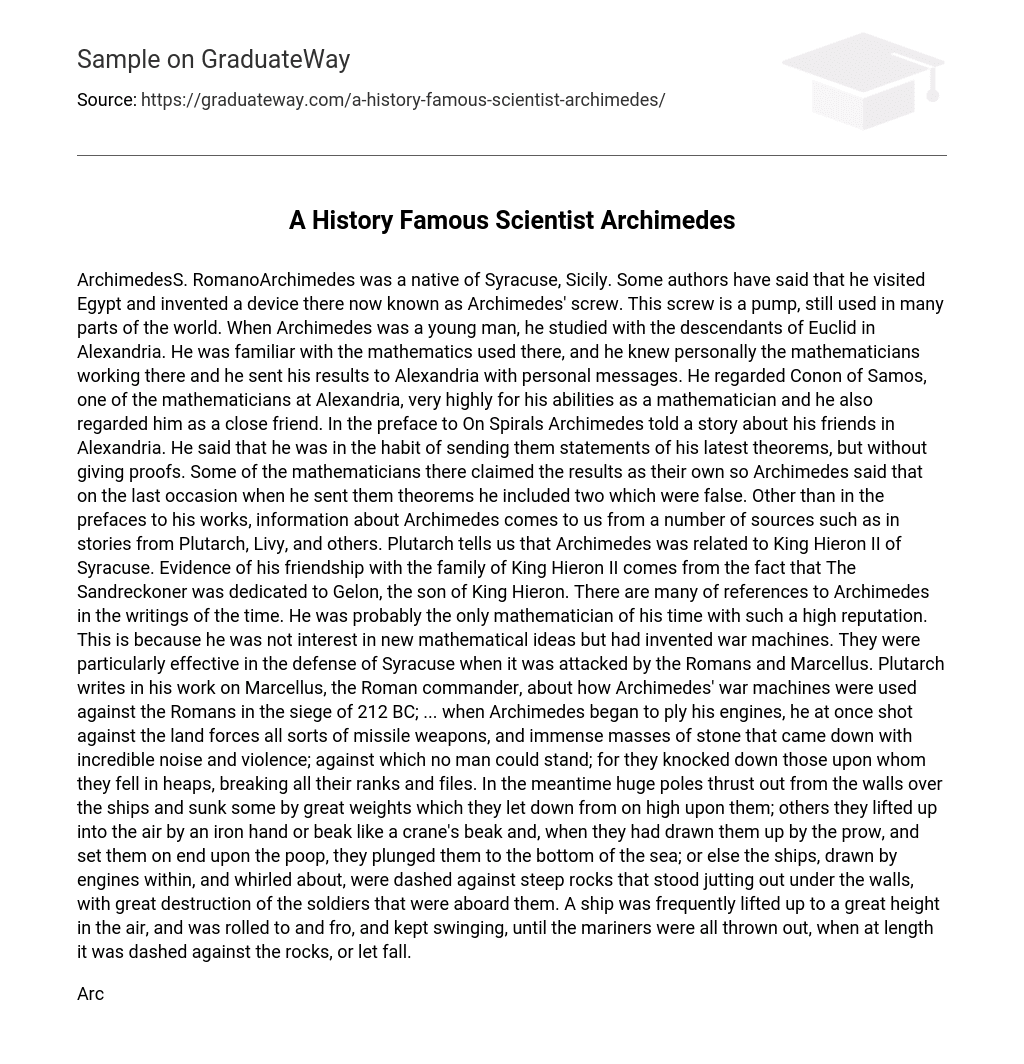Archimedes, who hailed from Syracuse, Sicily, is credited with inventing a device known as Archimedes’ screw during his rumored visit to Egypt. This screw, which functions as a pump, is still in use in various regions globally. During his youth, Archimedes received education from the descendants of Euclid in Alexandria. He possessed knowledge of the mathematical techniques employed there and had personal acquaintances among the mathematicians working in Alexandria. Archimedes would convey his findings to Alexandria alongside personalized messages. He held Conon of Samos, a mathematician in Alexandria, in high regard both for his mathematical prowess and their close friendship.
Archimedes recounted a tale about his acquaintances in Alexandria in the preface of On Spirals. He mentioned that he used to share his latest theorems with them but without presenting proofs. Certain mathematicians in Alexandria took credit for these results as their own. To thwart their actions, Archimedes included two false theorems in his last communication. Aside from his prefaces, details about Archimedes can be found in various sources such as Plutarch, Livy, and others.
According to Plutarch, Archimedes was connected to King Hieron II of Syracuse, and evidence of their friendship is seen in the dedication of The Sandreckoner to Gelon, Hieron’s son. References to Archimedes in contemporary writings highlight his distinguished reputation as the leading mathematician of his time. Unlike other mathematicians, Archimedes focused on inventing war machines rather than exploring new mathematical concepts.
In the defense of Syracuse against the Romans and Marcellus, Archimedes’ war machines proved to be particularly effective. Plutarch mentions in his work on Marcellus that during the siege of 212 BC, Archimedes used his engines to shoot various types of missile weapons and large stones against the land forces. These projectiles came down with tremendous noise and force, making it impossible for anyone to withstand them. They caused great damage by toppling over individuals and breaking their formations.
In the meantime, the ships were under attack by poles thrust out from the walls. Some ships were sunk by heavy weights that were lowered from above. Others were lifted into the air using a crane-like beak made of iron, and then dropped into the sea after being placed upright on the back end. Ships also faced destruction by being pulled by internal engines and thrown against steep rocks protruding from the walls, resulting in the deaths of many soldiers on board. Some ships were lifted high into the air and tossed back and forth until all sailors were thrown out, and then either crashed into rocks or fell to the ground.
Archimedes was persuaded by his friend, King Hieron, to build these machines. He had designed and contrived them as mere amusements in geometry, not of any great importance. This was in response to King Hiero’s desire and request for Archimedes to put some of his scientific speculations into practice and make them more accessible to the general public. Despite becoming famous for his mechanical inventions, Archimedes believed that mathematics was the only meaningful pursuit. Plutarch portrayed Archimedes with an exaggerated attitude, but in reality, Archimedes did utilize practical methods to derive results from pure geometry.
In On Spirals, Archimedes defines a spiral and presents properties that relate the length of the radius vector to the angles it has revolved through. He also discusses tangents to the spiral and methods for finding the area of specific portions of it. In his work On Conoids and Spheroids, Archimedes examines paraboloids of revolution, hyperboloids of revolution, and spheroids created by rotating an ellipse either around its major axis or minor axis. The main focus of this work is to study the volume of segments of 3-D figures.
Archimedes believed that his most significant achievements revolved around a situation where a cylinder enclosed a sphere. He desired for this concept, along with his findings on the ratio between the two shapes, to be immortalized on his tomb. Cicero, who was present in Sicily in 75 BC, recounts his quest to locate Archimedes’ final resting place. The tomb was discovered overgrown with brambles and thickets, but recognizing certain verses inscribed on the tomb which mentioned a sphere and cylinder placed atop the grave, Cicero persevered. Eventually, he spotted a small column emerging from the bushes bearing the depiction of a sphere and cylinder. Slaves were summoned and equipped with sickles to clear a path, enabling them to reach the pedestal. Although only half of the lines were still legible due to erosion, the inscription was still partially discernible.





